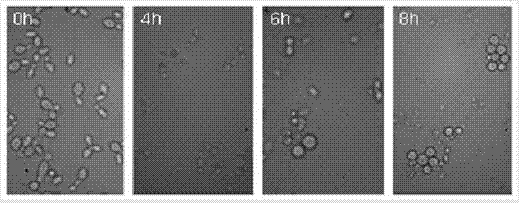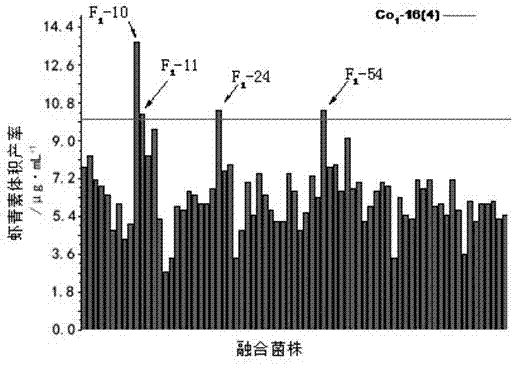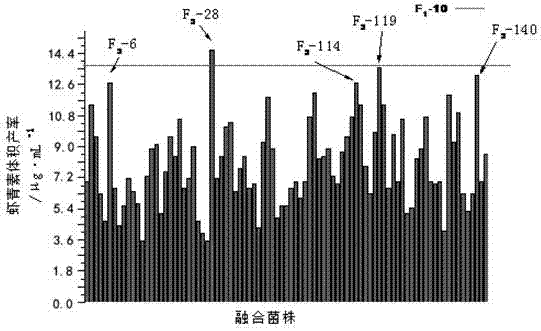Co-production fermentation method for astaxanthin and mannan and application of astaxanthin and mannan
A technology of mannan and fermentation method, which is applied in the field of preparation of astaxanthin and mannan, and achieves the effects of breaking walls, high economic value and wide application range
- Summary
- Abstract
- Description
- Claims
- Application Information
AI Technical Summary
Problems solved by technology
Method used
Image
Examples
Embodiment 1
[0036] The co-production fermentation method of astaxanthin and mannan includes: mutagenesis, preparation of protoplasts, genome rearrangement, acquisition of astaxanthin, and extraction of mannan, specifically including the following steps:
[0037] Mutagenesis: Dilute the activated and cultured Phaffia rhodozyma suspension to 1×10 6 cells / mL, take 5mL of bacterial suspension in a Petri dish with a magnetic rotor, add 300μL of 10% LiCl aqueous solution, mix well, open the cover and irradiate with ultraviolet rays. Plates were cultured in a constant temperature incubator at 20°C for 4 days; at the same time as LiCl-ultraviolet compound mutagenesis, the concentration of the prepared bacterial suspension was adjusted to 1×10 6 cells / mL, take the bacterial suspension in a sterile test tube, and send it to the cobalt room of Zhejiang Academy of Agricultural Sciences for 60 Co-γ-ray mutagenesis; lithium chloride is an alkali metal halogenating agent, which has no mutagenic effect ...
Embodiment 2
[0045] 1) Determination of astaxanthin:
[0046] Take 5 mL of fermentation broth and centrifuge at 5000 rpm for 10 minutes, wash twice with deionized water, collect the bacteria, blot the water droplets on the tube wall with filter paper, add 1 mL of dimethyl sulfoxide preheated at 55°C, shake and suspend, add 4 mL of acetone, and vortex 20-30s, 4°C, centrifuge at 5000rmp for 10min, measure the OD of the supernatant with a spectrophotometer 474 . If the sludge is still colored, it can be repeatedly extracted until it becomes white. The formula for calculating the astaxanthin content is as follows:
[0047]
[0048] Where: OD 474 ——the absorbance of the extract at a wavelength of 474nm; V l ——the total volume of organic solvent, mL; V 2 - volume of fermentation broth, mL; W - dry weight of cells, g; 0.21 - extinction coefficient of organic solvent;
[0049] 2) Determination of cell biomass:
[0050] Take 5 mL of bacterial suspension, centrifuge at 5000 rpm for 10 minut...
Embodiment 3
[0052] Mutation of Phaffia rhodozyma cells:
[0053] Dilute the activated and cultured Phaffia rhodozyme bacterial suspension to 1.2×10 6 cells / mL, take 10mL of bacterial suspension in a petri dish with a magnetic rotor, add 350 μL of 12% LiCl aqueous solution, mix well, open the cover and irradiate with ultraviolet rays. plate, cultured in a constant temperature incubator at 22°C for 5 days; at the same time of LiCl-ultraviolet compound mutagenesis, the concentration of the prepared bacterial suspension was adjusted to 1.2×10 6 cells / mL, take the bacterial suspension in a sterile test tube, and send it to the cobalt room of Zhejiang Academy of Agricultural Sciences for 60 Co-γ-ray mutagenesis; lithium chloride is an alkali metal halogenating agent, which has no mutagenic effect itself, but it is combined with ultraviolet rays, and within a certain concentration range, it is conducive to the occurrence of positive mutations in bacteria; the lethality of bacteria is selected ...
PUM
 Login to View More
Login to View More Abstract
Description
Claims
Application Information
 Login to View More
Login to View More - R&D
- Intellectual Property
- Life Sciences
- Materials
- Tech Scout
- Unparalleled Data Quality
- Higher Quality Content
- 60% Fewer Hallucinations
Browse by: Latest US Patents, China's latest patents, Technical Efficacy Thesaurus, Application Domain, Technology Topic, Popular Technical Reports.
© 2025 PatSnap. All rights reserved.Legal|Privacy policy|Modern Slavery Act Transparency Statement|Sitemap|About US| Contact US: help@patsnap.com



